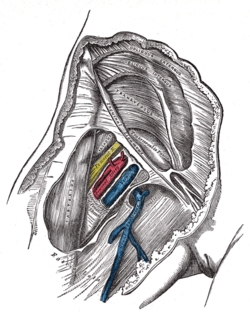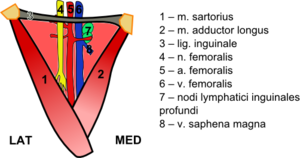The femoral triangle is a hollow region located in the supero-medial part of the anterior thigh. It appears most prominently with hip flexion, abduction and internal rotation. It is an easily accessible area through which multiple neurovascular structures pass through. This anatomical landmark is mostly used in dissection and describing relationships in the groin area. It is also known as "scarpa's triangle" and "femoral trigone".
 |
| Femoral Triangle |
Contents
The following structures pass through the femoral triangle:
- Femoral nerve - Which innervates the anterior compartment of the thigh
- Femoral sheath containing:
- Femoral artery and branches - Arterial supply for majority of the lower limb
- Femoral vein - The great saphenous vein drains into the femoral vein within the triangle
- Femoral canal - Contains lymph nodes and vessels
- Superfical and deep inguinal lymph nodes and vessels
Borders
The femoral triangle has three borders namely:
- Superior (base of triangle): Inguinal ligament
- Lateral: Medial border of the sartorius muscle
- Medial: Medial border of the adductor longus
- Apex: Cross between medial and lateral border
Floor and roof
The floor of the femoral triangle is comprised of the adductor longus, pectineus (medially), psoas major and illiacus muscles (laterally). The floor is gutter shaped since all the muscles forming the floor pass to the posterior aspect of the femur.
The roof of the femoral triangle consists of skin, superficial and deep fascia (fascia lata, cribiform fascia) of the the thigh and subcutaneous tissue.
Clinical Significance
Assessment of pain and swelling in this area can be done by palpation or ultrasound. It is mostly caused by the following:
- Abscesses
- Cellulitis
- Haematoma
- Nodal enlargement
- Femoral artery aneurysm
- Femoral vein thromobplebitis
- Femoral hernias (mostly at proximal opening, a weak areas in the lower abdominal wall)
Clinically, the area is also commonly used for the following:
- Femoral pulse palpation
- Drawing blood from the femoral artery
- Vascular catheterization for interventional and corrective procedures
- Provides access to ipsilateral and contralateral leg, abdominal, thoracic and cerebral vessels
- Femoral artery catherization to access the aortic arch through the abdominal and descending aorta as well as the left side of the heart.
- Used in aortic valve replacements, angiography and angioplasty
- Femoral vein: Access right side of heart via inferior vena cava.
- Used with patent foramen ovale repair.




0 Comments